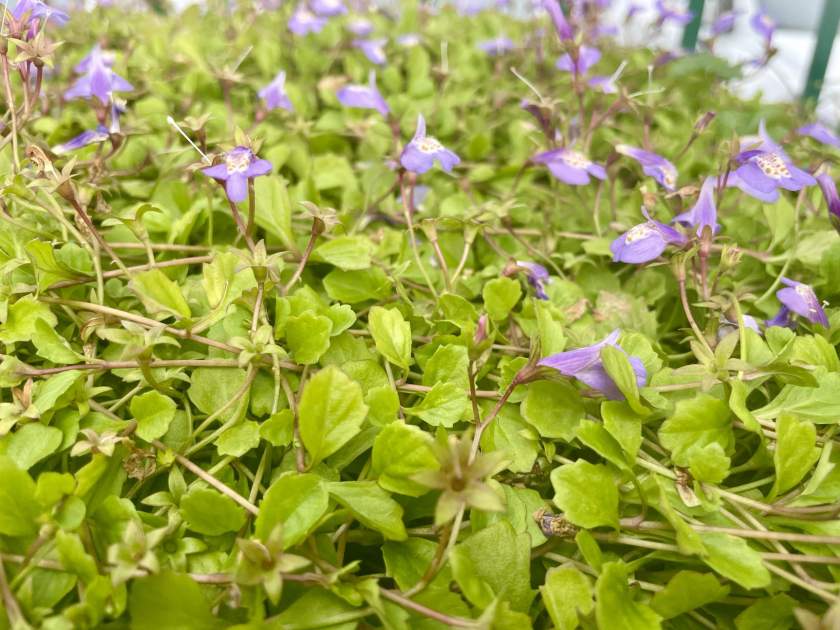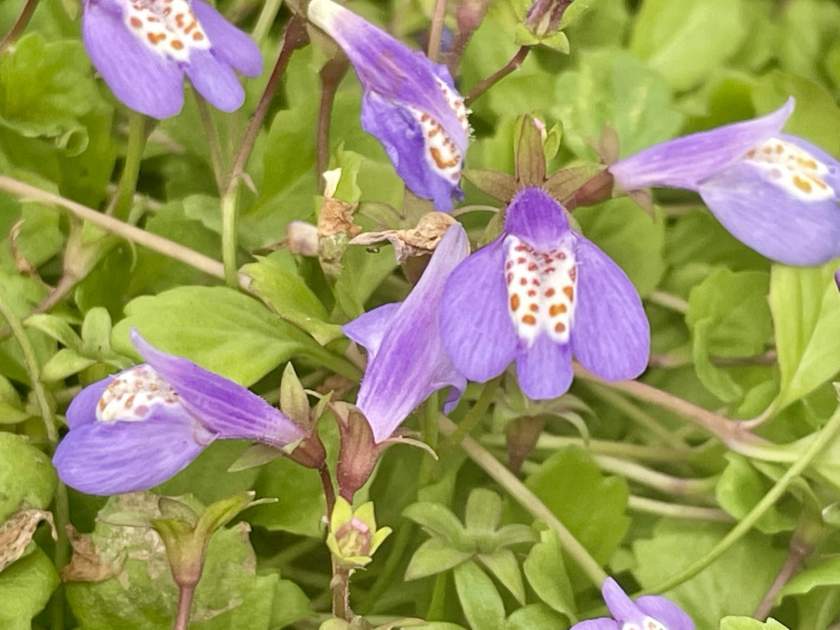Mazus reptans, commonly known as Creeping Mazus, is a fast-spreading semi-evergreen herbaceous perennial that serves as an excellent ground cover option in USDA zones 5 to 8. It belongs to the Mazaceae family of plants. This adaptable plant features dense and lush foliage that remains green throughout the year in warmer climates. It produces clusters of beautiful little purple-blue flowers, adding a touch of color to the landscape during late spring and summer. The tiny thumbnail-sized flowers form a dense mat and can be mowed similarly to turf grass.
Originating from Central Asia, particularly the Himalayas, Creeping Mazus is typically planted from potted nursery starts or root divisions in the spring. As a fast-growing plant, it quickly fills in the area, creating a uniform ground cover. It grows to a height of 2–3 inches (5–7.6 cm) tall and spreads to a width of 6–12 inches (15–30 cm).
Growing Care for Creeping Mazus:
Creeping Mazus prefers relatively moist fertile soil in a full-sun location, but it is adaptable and can tolerate various soil types. It can also grow reasonably well in partial shade, although it may exhibit slower growth with fewer flowers in such conditions.
Creeping Mazus thrives in full sun or partial shade positions. In hot regions, providing some afternoon shade is beneficial. This plant prefers fertile, moist, and loamy soil. However, it exhibits robustness and can tolerate different soil types. To ensure the proper establishment, avoid hard-packed soil that hampers the delicate rooting system. Creeping Mazus adapts well to both acidic and alkaline soils. In drier conditions, adding mulch helps retain moisture.
Creeping Mazus prefers moist but not waterlogged soil. Avoid overwatering, as it can lead to root rot. Regular watering, particularly in hot and dry conditions, promotes healthy growth. If the foliage starts to wilt and die, it may indicate a lack of moisture. This plant adapts to a wide range of temperatures and is reliably hardy in USDA zones 5 to 8. It thrives in warm and moist environments, displaying evergreen characteristics in warmer climates. In colder zones, the foliage may turn red and go dormant during winter. A hard frost can cause individual plants to die, but the colony usually regenerates with mild spring weather.
In rich and fertile soil, Creeping Mazus generally doesn’t require additional feeding. However, if the plant is in dry or poor-quality soil, an annual light feeding with a slow-release fertilizer in spring can promote better growth. While not necessary, Creeping Mazus responds well to shearing with a mower when used as a turfgrass replacement in ground-cover situations.

Propagating Mazus reptans:
Creeping Mazus naturally spreads as its stems root themselves in the soil. Transplanting offshoots is a simple method of propagation:
- During active growth in spring, use a sharp knife or trowel to separate a rooted offshoot stem from the mother plant.
- Immediately plant the offshoot in a new location, ensuring adequate watering.
- When establishing a ground cover, space the plants 8 to 12 inches apart, as they will quickly spread to fill the space
Growing Creeping Mazus from Seed: While Creeping Mazus is typically planted using nursery seedling flats, it is possible to sow bulk seeds over a large area, similar to sowing lawn seed. However, if you’re seeding an area previously covered with grass, ensure you remove as much grass as possible, including the roots, to give Creeping Mazus the best chance to thrive. Provide sufficient spacing between the seeds to accommodate the plant’s fast-spreading and close-to-the-surface root system.
Potting and Repotting: Although it’s not a common method, Creeping Mazus can be grown in containers filled with standard potting mix. Its low-growing trailing habit makes it suitable as a “spiller” plant for the edges of mixed container gardens. Any type of container works, as long as it provides good drainage.
Overwintering: Creeping Mazus generally requires no special winter preparation. In colder zones, applying a layer of leaf mulch over the plants can prevent winter damage. Remove the covering as soon as the weather warms in spring.
Common Pests and Plant Diseases: Creeping Mazus is not prone to serious pests or diseases. However, it can be susceptible to damage from slugs and snails. These pests can be manually removed or controlled using snail/slug baits placed in the garden.
Creeping Mazus typically blooms during its regular flowering period, from late spring to mid-summer. Insufficient sunlight or water can hinder blooming. Ensure that the plant receives adequate amounts of both for prolific flowering. If cultural needs are met and blooming remains inadequate, balanced fertilizer application may provide the necessary nutritional boost.
Creeping Mazus rarely encounters cultural issues within its established hardiness range. However, brown patches may appear in an otherwise uniform carpet of green. In colder regions, this can be a result of winter kill due to hard frost. Winter kill usually resolves itself in spring as surrounding plants fill in the dead patches.
Brown patches can also occur if the soil becomes too dry. Creeping Mazus requires ample moisture and may die back if subjected to prolonged dryness during hot months.
Mazus reptans is a tiny perennial plant, growing only 2 inches (5 cm) tall. It forms a dense mat of foliage that remains green throughout spring and summer, extending into fall. Adorned with tiny blue flowers during summer, Mazus reptans serves as an attractive ground cover. While it spreads aggressively, it is not considered invasive outside of cultivated areas.
By understanding its growth habits and providing suitable conditions, you can enjoy the beauty and resilience of Creeping Mazus in your garden or landscape.




